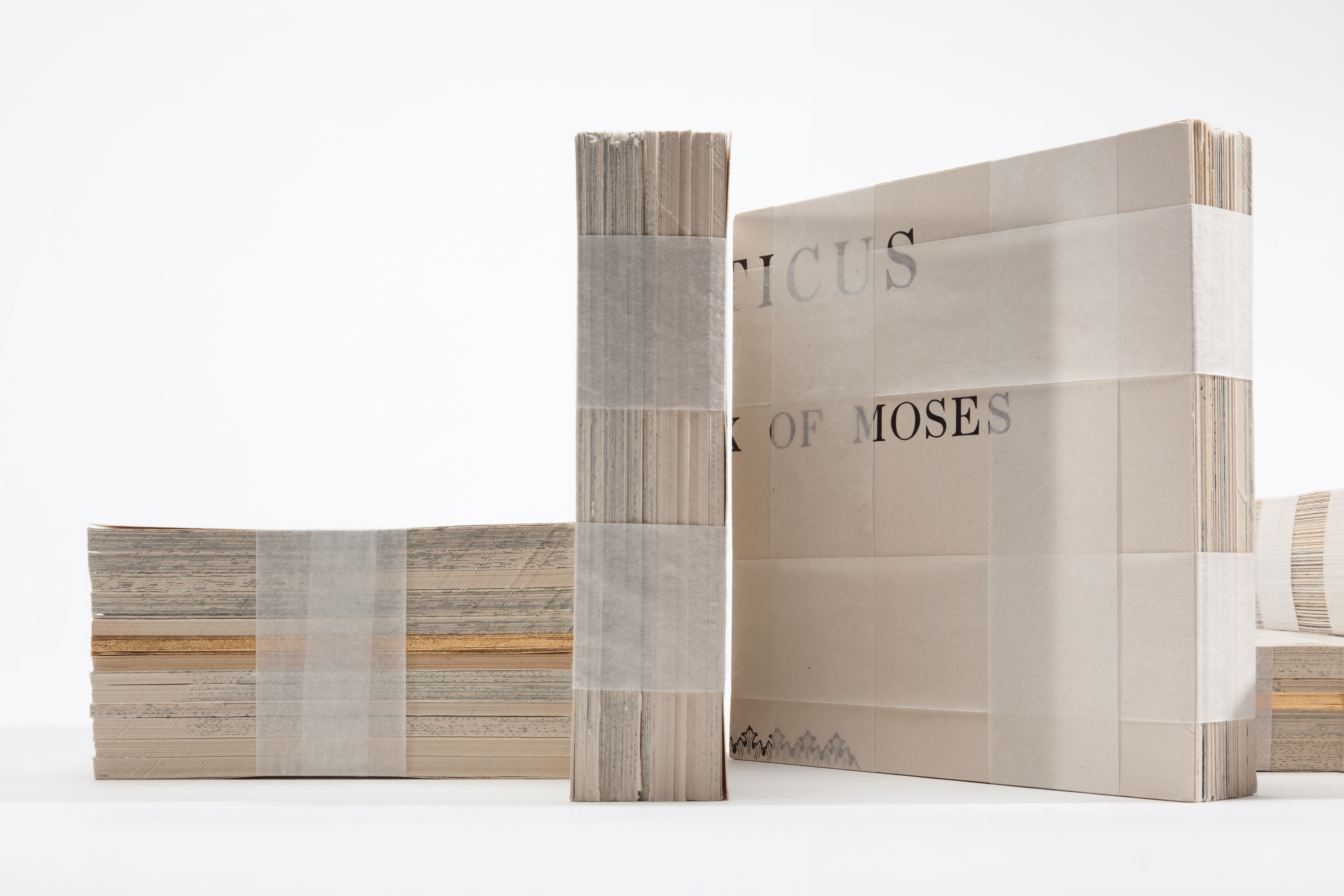









Old Testament
Perhaps the most widely known book worldwide is the Bible. Especially in the West where it was the first mass-printed book, its influence in history and literature has been major. Despite our basic familiarity and the positive or negative response one may have had to it or to aspects of it, this work utilizing and transforming the Bible and the Psalms alters one’s previous experience of these classic texts. Reinventing the books, completely free of theological or political filters, I am not only exploring their physical integrity but also creating new hybrid forms which reflect memory, history and sanctity.
The Old Testament Series takes its material, intellectual, and spiritual inspiration from my paternal grandfather's The Old Testament, Part I & II, James Tissot, M. Brunhoff & Co., 1904.
Each of the Five Books of Moses has been cut down, stacked, and bound with strips of gampi tissue as individual repositories. The resulting simplicity of the singular blocks of paper and the tenuous quality of their containment contrasts sharply with the complexity of the stories recorded. The text and illustrations remain hidden with no access to the actual contents of the book. Yet the simple physical presence of these varying shapes evocative of Jung's sacred geometry, emphasizes their literal, historical, and spiritual impact. The imprint on our consciousness, not the actual details of the stories is therefore emphasized. The now blunt cut edges of the sliced and recombined chapters often retain their gilt edging and fragments of decorative embellishments - a hint of the volume’s previously treasured and favored status.
As a collective grouping, the five differing shapes offer a progression and a presentation wherein they are interrelated yet are also self-contained. The interplay of depth, volume, surface, and structure engage and intrigue while being non-specific. They stand as an inculcation of their transformation and a tribute to the sacred bond of friendship and community.
Gold-leafed strips are woven forming a fairly dense interlaced grid containing pages of Kings - evoking power, wealth and control. Knotted threads extend from the intersections, implying a continuation of influence.
The Prophets’ surface is embellished and bound with 22 karat gold leaf , symbolically suggesting the contents which are believed to be a manifestation of God. These inspirational stories are contained in the underlying solid block of paper boldly formed yet tentatively restrained by strips of gold leaf and gampi tissue, presenting a compelling compilation. The resulting visual simplicity purposefully contrasts with the complexity of its contents.
Triangular in shape, Psalms is capped at its ends by gold leaf, most precious of metals. Like a sacred mountain the triangle is associated with the ability to envision new possibilities and in this context represents the inspirational lines of text such as "and lead me in the way everlasting."
The Book of Esther is bound together by interweaving strips of translucent gampi tissue. Linen thread reinforces the layers of tissue. Knots adorned with pearls, accented by the loose strands of the threads, build the textural surfaces. The simple embellishment alludes to Queen Esther's position, influence and impact. The pearls number eighteen - the numerical equivalent of life/chai.
The Covenant similarly is a composite of six equally-sized cut stacks of the book’s pages which are individually bound by gampi tissue, tied and knotted together with the linen binding thread from the original volume. The resulting shape has a solid yet fragile presence. The contrast implied by the consummate block of paper delicately restrained parallels and symbolizes the agreement of being bound by a solemn compact.
"....each object in her Old Testament Series provides a means for various kinds of contemplation. The series is literally composed of cut down, bound, and stacked parts of her paternal grandfather's nineteenth century Bible. Its calming presence provides a transformative sacred space, an "immersive experience" according to Kunstadt, for spiritual uplift and meditation about one's own family as well as the contents of the books that make up the Hebrew Bible. Aesthetic values dominate textual ones through the interplay of depth, volume, surface textures, and structure with the complex stories hidden within. At the same time, the objects are both interrelated and stand alone."
–Adrianne Rubin, As Subject and Object: Contemporary Book Artists Explore Sacred Hebrew Texts, MoBIA, New York, NY